Spatial-Temporal Change Characteristic Analysis and Environmental Risk Evaluation of Pesticide Application in Anhui Province
Abstract
:1. Introduction
2. Research Area
3. Materials and Methods
3.1. Basic Data
3.1.1. Data Source
3.1.2. Data Processing
3.2. Evaluation Method of Environmental Risk
3.3. Theory of Spatial Autocorrelation
3.3.1. Global Spatial Autocorrelation
3.3.2. Local Spatial Autocorrelation
4. Results and Discussion
4.1. Results of PAI
4.2. Results of Spatial Autocorrelation Analysis
4.3. Pesticide Environmental Risk
5. Conclusions and Recommendations
5.1. Conclusions
5.2. Recommendations
Funding
Conflicts of Interest
References
- Kaur, P.; Balomajumder, C. Simultaneous biodegradation of mixture of carbamates by newly isolated Ascochyta sp. CBS 237.37. Ecotoxicol. Environ. Saf. 2019, 169, 590–599. [Google Scholar] [CrossRef] [PubMed]
- Tudi, M.; Daniel, R.H.; Wang, L.; Lyu, J.; Sadler, R.; Connell, D.; Chu, C.; Phung, D.T. Agriculture development, pesticide application and its impact on the environment. Int. J. Environ. Res. Public Health 2021, 18, 1112. [Google Scholar] [CrossRef]
- Onwujiogu, V.C.; Abugu, H.O.; Okoye, C.O.B. Health risk assessment of pesticide residue in freshly harvested Vigna subterranea (Bambara nut) in Nsukka South Eastern Nigeria. Environ. Monit. Assess. 2022, 194, 536. [Google Scholar] [CrossRef]
- Mahdavi, V.; Gordan, H.; Ramezani, S.; Khaneghah, A.M. National probabilistic risk assessment of newly registered pesticides in agricultural products to propose maximum residue limit (MRL). Environ. Sci. Pollut. Res. 2022, 29, 55311–55320. [Google Scholar] [CrossRef] [PubMed]
- Chen, L.; Qian, Y.Z.; Jia, Q.; Weng, R.; Zhang, X.L.; Li, Y.; Qiu, J. A large geographic-scale characterization of organochlorine pesticides (OCPs) in surface sediments and multiple aquatic foods of inland freshwater aquaculture ponds in China: Co-occurrence, source and risk assessment. Environ. Pollut. 2022, 308, 119716. [Google Scholar] [CrossRef]
- Mingistry of Agriculture and Rural Affairs of the People’s Republic of China. Action Plan for Zero Growth of Pesticide Use by 2020. 2015. Available online: www.moa.gov.cn/govpublic/ZZYGLS/201503/t20150318_4444765.htm (accessed on 15 July 2022). (In Chinese)
- Zhang, Z.J. Macroscopic Logic and Empirical Test of Agricultural Green Production—Taking Pesticide Application as an Example. J. Shandong Agric. Univ. (Soc. Sci. Ed.) 2022, 24, 97–106, 108. (In Chinese) [Google Scholar]
- FAOSTAT. FAO Statistical Databases. 2017. Available online: http://www.fao.org/faostat/en/#home (accessed on 15 July 2022).
- Zhao, L.; Teng, Y.; Luo, Y.M. Present Pollution Status and Control Strategy of Pesticides in Agricultural Soils in China: A Review. Soils 2017, 49, 417–427. (In Chinese) [Google Scholar]
- Wang, X.; Zhang, Q.Z.; Zhao, G.F.; Wang, X.Y. Distribution and potential risk of organochlorine pesticides in the soil of a submerged area around Miyun reservoir. Environ. Sci. 2019, 40, 3058–3067. (In Chinese) [Google Scholar]
- Manjarres-López, D.P.; Andrades, M.S.; Sánchez-González, S.; Herrero-Hernández, E. Assessment of pesticide residues in waters and soils of a vineyard region and its temporal evolution. Environ. Pollut. 2021, 284, 117463. [Google Scholar] [CrossRef]
- Xu, X.; Li, C.M.; Sun, J.; Wang, H.L.; Wang, D.H.; Song, H.W.; Wang, Z.J. Residue characteristics and ecological risk assessment of twenty-nine pesticides in surface water of major river-basin in China. Asian J. Ecotoxicol. 2016, 11, 347–354. (In Chinese) [Google Scholar]
- Ramírez-Morales, D.; Pérez-Villanueva, M.E.; Chin-Pampillo, J.S.; Aguilar-Mora, P.; Arias-Mora, V.; Masís-Mora, M. Pesticide occurrence and water quality assessment from an agriculturally influenced Latin-American tropical region. Chemosphere 2021, 262, 127851. [Google Scholar] [CrossRef] [PubMed]
- Jumars, P.A. Spatial autocorrelation with RUM (Remote Underwater Manipulator): Vertical and horizontal structure of a bathyal benthic community. Deep Sea Res. 1978, 25, 589–604. [Google Scholar] [CrossRef]
- Mollalo, A.; Rivera, K.M.; Vahabi, N. Spatial statistical analysis of pre-existing mortalities of 20 diseases with COVID-19 mortalities in the continental United States. Sustain. Cities Soc. 2021, 67, 102738. [Google Scholar] [CrossRef] [PubMed]
- Ye, W.F.; Ma, Z.Y.; Ha, X.Z. Spatial-temporal patterns of PM2.5 concentrations for 338 Chinese cities. Sci. Total Environ. 2018, 631–632, 524–533. [Google Scholar] [CrossRef]
- Santa Cruz, F.; Ernst, B.; Arata, J.A.; Parada, C. Spatial and temporal dynamics of the Antarctic krill fishery in fishing hotspots in the Bransfield Strait and South Shetland Islands. Fish. Res. 2018, 208, 157–166. [Google Scholar] [CrossRef]
- Li, S.S.; Li, Y.B.; Wang, M.M.; Luo, G.J. The evolution of land use structure in karst valley area based on micro-space unit. J. Nat. Resour. 2020, 35, 908–924. (In Chinese) [Google Scholar]
- Overmars, K.P.; Koning, G.H.J.; Veldkamp, A. Spatial autocorrelation in multi-scale land use models. Ecol Modeling 2003, 164, 257–270. [Google Scholar] [CrossRef]
- Wu, Y.M.; Xu, J.H. A spatial analysis on China’s regional economic growth clustering. Sci. Geogr. Sin. 2004, 24, 654–659. (In Chinese) [Google Scholar]
- Anhui Provincial Bureau of Statistics. Anhui Statistical Yearbook. 2004–2021. Available online: http://tjj.ah.gov.cn/ssah/qwfbjd/tjnj/index.html (accessed on 15 July 2022). (In Chinese)
- National Bureau of Statistics. China Statistical Yearbook. 2004–2021. Available online: http://www.stats.gov.cn/tjsj/ndsj/ (accessed on 15 July 2022). (In Chinese)
- Ministry of Ecology and Environment of the People’s Republic of China. National Ecological Civilization Construction Demonstration Villages and Towns Indicators (Trial). 2014. Available online: https://www.mee.gov.cn/gkml/hbb/bwj/201401/t20140126_266962.htm (accessed on 15 July 2022). (In Chinese)
- He, X.Q. A Study on Non-sudden Environmental Risk. China Environ. Sci. 1990, 10, 218–223. (In Chinese) [Google Scholar]
- Rapant, S.; Kordik, J. An environmental risk assessment map of the Slovak Republic: Application of data from geochemical atlases. Environ. Geol. 2003, 44, 400–407. [Google Scholar] [CrossRef]
- Liu, Q.P. Regional difference of NPK fertilizers application and environmental risk assessment in Jiangsu Province, China. hin. J. Appl. Ecol. 2015, 26, 1477–1483. (In Chinese) [Google Scholar]
- Wu, X.B.; Sun, Q.; Shi, T.Z.; Ma, X.; Li, X.D.; Hua, R.M. Characteristics and risk assessment of pesticide residues in soil of a strawberry base in Anhui province. J. Food Saf. Qual. 2021, 12, 5931–5939. (In Chinese) [Google Scholar]
- Ministry of Ecology and Environment of the People’s Republic of China. Soil Environmental Quality-Risk control Standard for Soil Contamination of Development Land. 2018. Available online: https://www.mee.gov.cn/ywgz/fgbz/bz/bzwb/trhj/201807/W020190626595212456114.pdf (accessed on 1 September 2022). (In Chinese)
- Moran, P.A.P. The Interpretation of Statistical Maps. J. R. Stat. Soc. Ser. B (Methodol.) 1948, 10, 243–251. [Google Scholar] [CrossRef]
- Geary, R. The contiguity ratio and statistical mapping. Inc. Stat. 1954, 5, 115–145. [Google Scholar] [CrossRef]
- Getis, A.; Ord, K. The analysis of spatial association by use of distance statistics. Geogr. Anal. 1992, 24, 189–206. [Google Scholar] [CrossRef]
- Anselin, L. Local Indicators of Spatial Association—LISA. Geogr. Anal. 2010, 27, 93–115. [Google Scholar] [CrossRef]
- Anselin, L. GeoDaTM User’s Guide. Available online: www.geoda.uiuc.edu (accessed on 15 July 2022).
- Wang, X.Q. The Distribution and Risk Assessment of Organochlorine Pesticides Residues in Farmland Soils and Grains in Anhui Province, China. Master’s Thesis, Anhui Agricultural University, Hefei, China, 2011. (In Chinese). [Google Scholar]
- Jiang, P.H. Analysis Ofeconomic Factors Affecting Pesticide Application: A Case Study of Fujiang Province. Master’s Thesis, Fujian Agriculture and Forestry University, Fuzhou, China, 2005. (In Chinese). [Google Scholar]
- Xie, L.J.; Xue, C.; Mao, J.Y.; Bi, T.S.; Da, C.N. Occurrence and Distribution of Organochlorine Pesticides (OCPs) in Surface Sediments of Huaihe River (Anhui Section). J. Bengbu Univ. 2021, 10, 12–18. (In Chinese) [Google Scholar]
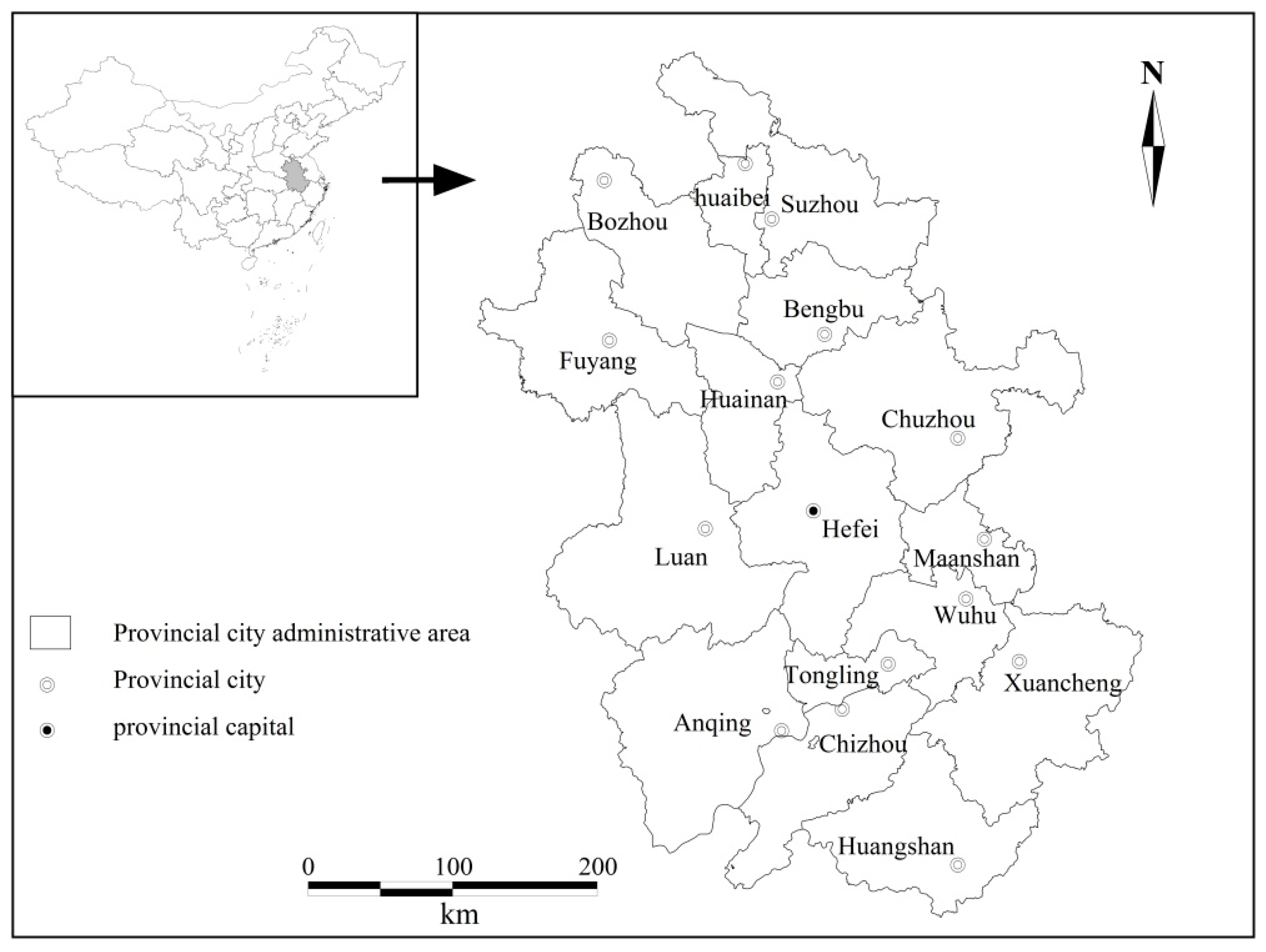

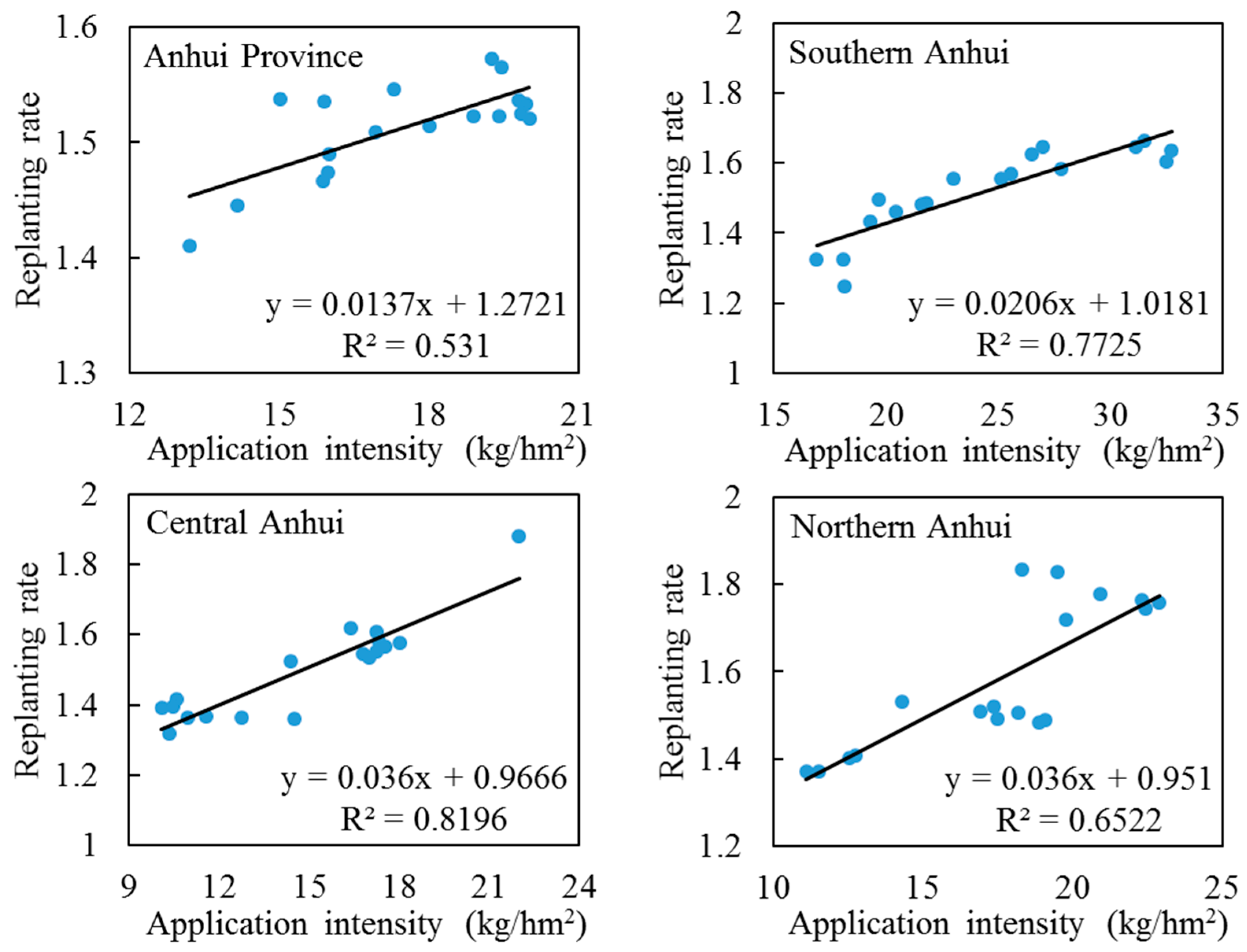

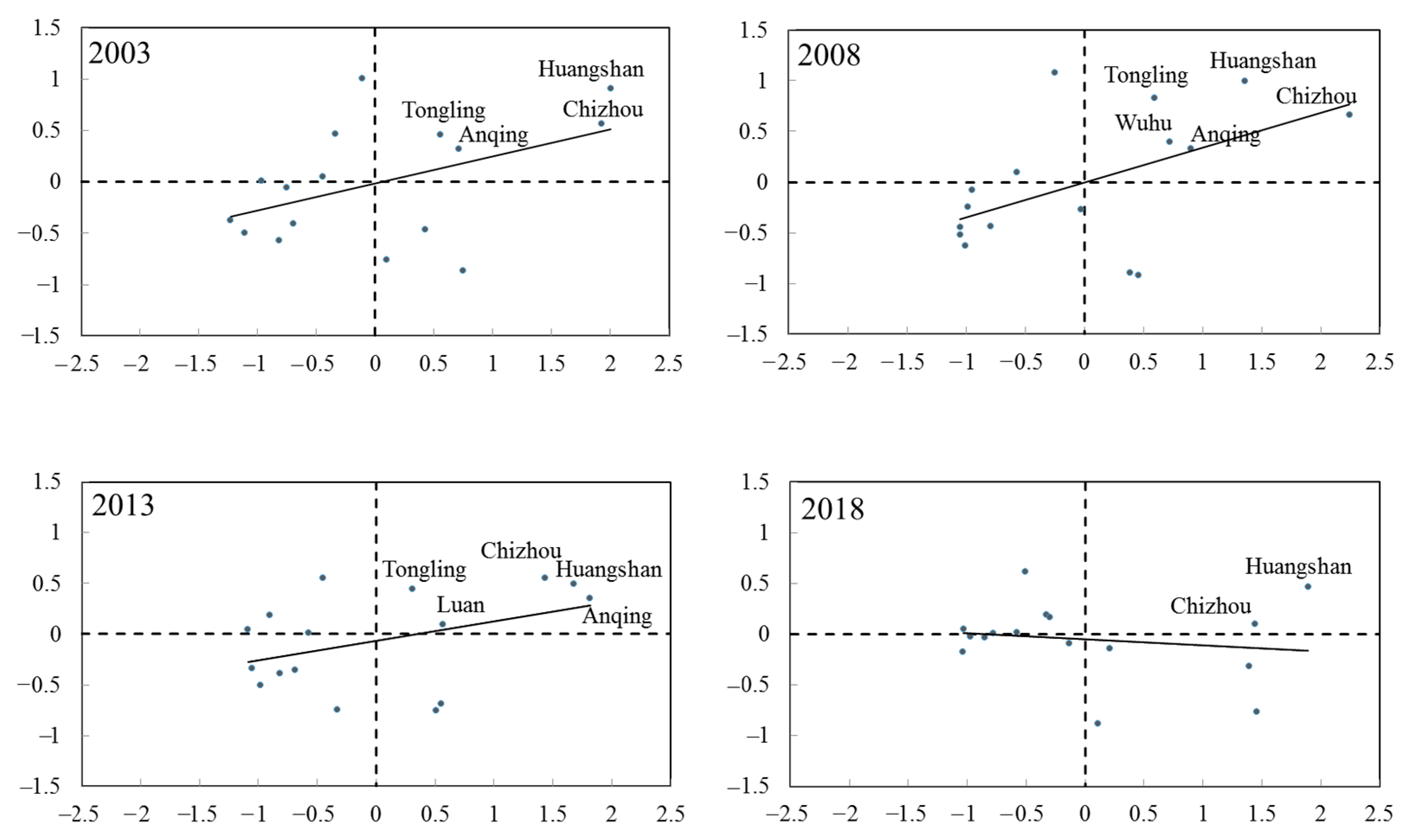
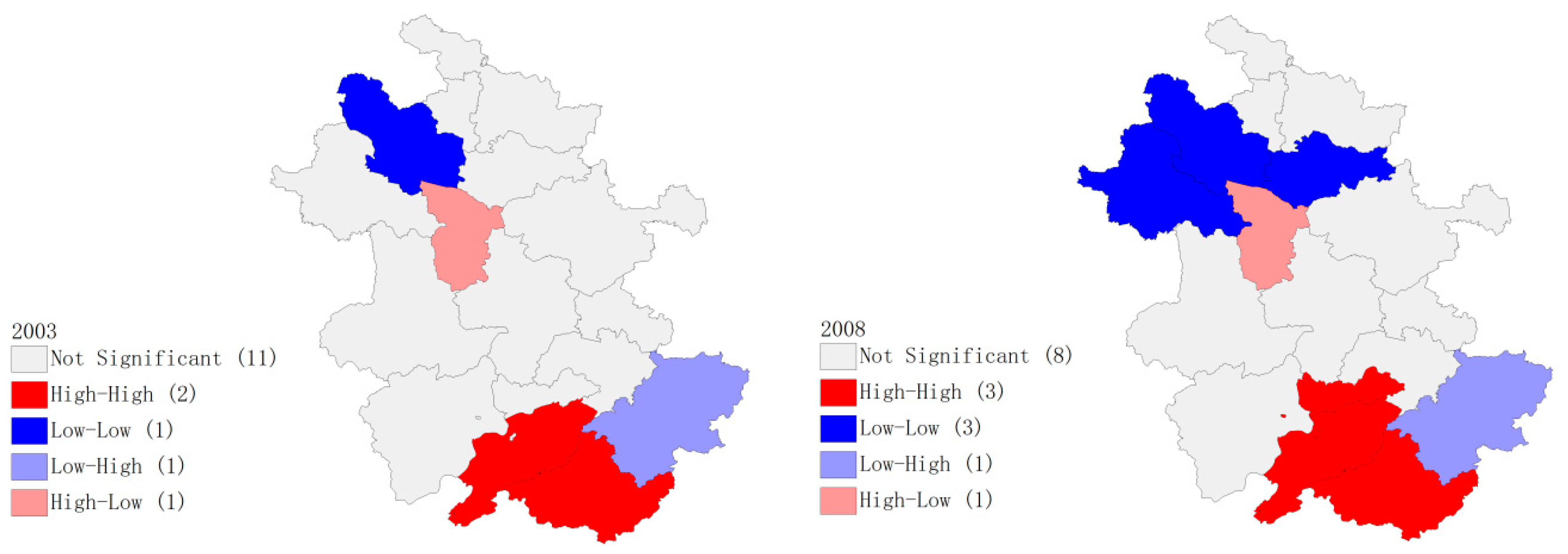
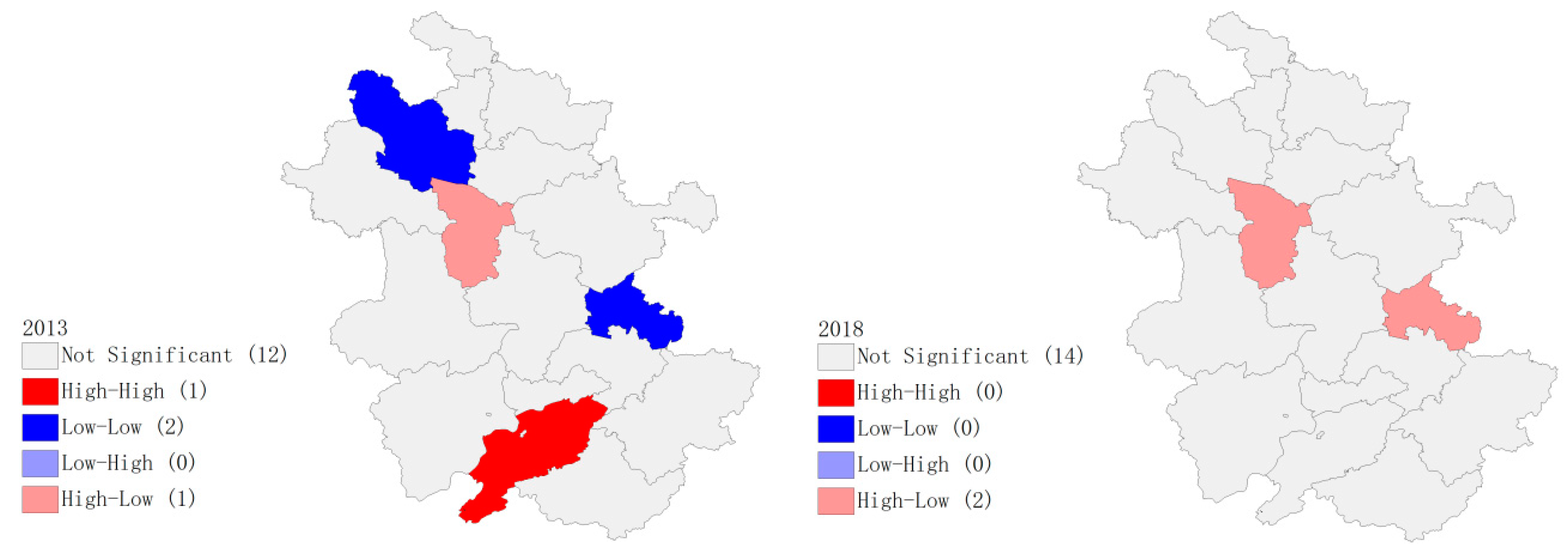

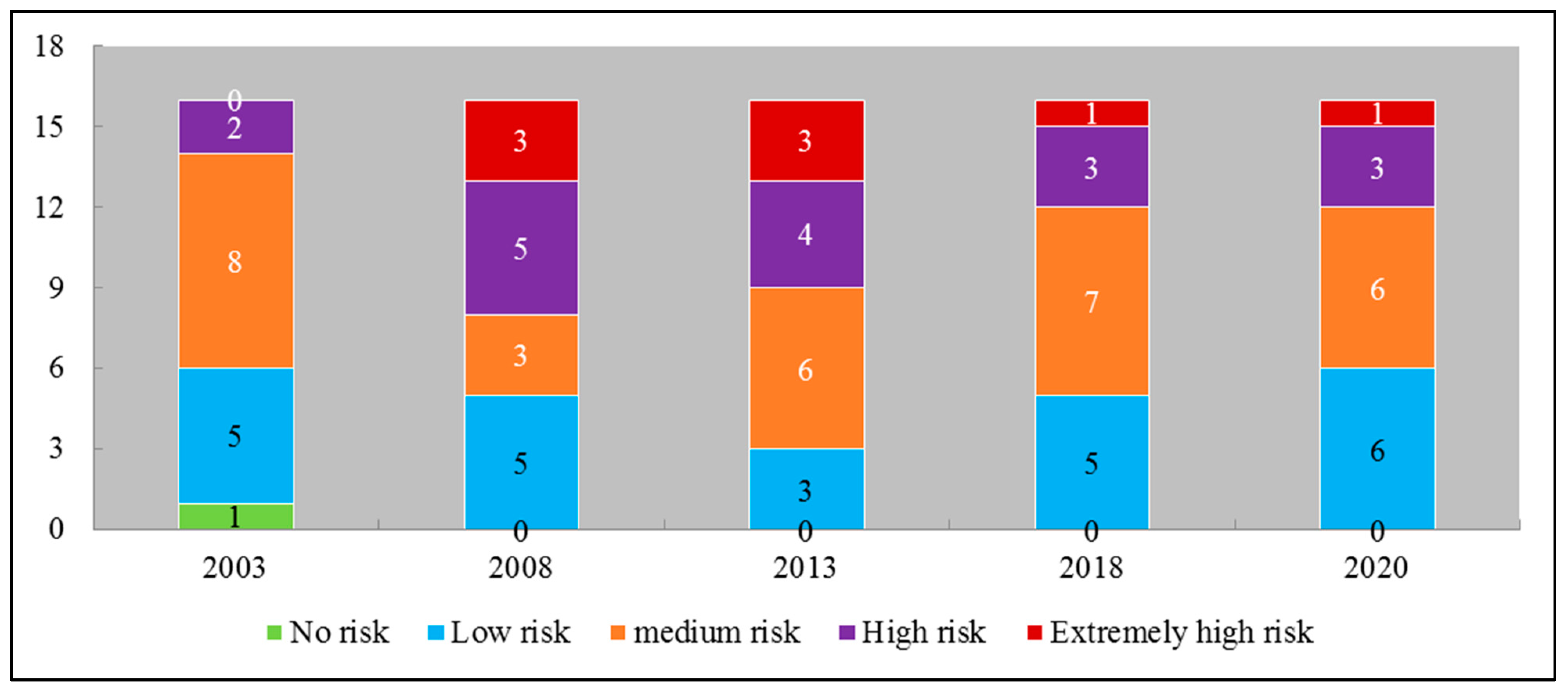
| Risk Level | No Risk | Low Risk | Medium Risk | High Risk | Extremely High Risk |
|---|---|---|---|---|---|
| Risk index | 0 | 0~1 | 1~3 | 3~5 | >5 |
Publisher’s Note: MDPI stays neutral with regard to jurisdictional claims in published maps and institutional affiliations. |
© 2022 by the author. Licensee MDPI, Basel, Switzerland. This article is an open access article distributed under the terms and conditions of the Creative Commons Attribution (CC BY) license (https://creativecommons.org/licenses/by/4.0/).
Share and Cite
Zhou, Q. Spatial-Temporal Change Characteristic Analysis and Environmental Risk Evaluation of Pesticide Application in Anhui Province. Sustainability 2022, 14, 11735. https://doi.org/10.3390/su141811735
Zhou Q. Spatial-Temporal Change Characteristic Analysis and Environmental Risk Evaluation of Pesticide Application in Anhui Province. Sustainability. 2022; 14(18):11735. https://doi.org/10.3390/su141811735
Chicago/Turabian StyleZhou, Qi. 2022. "Spatial-Temporal Change Characteristic Analysis and Environmental Risk Evaluation of Pesticide Application in Anhui Province" Sustainability 14, no. 18: 11735. https://doi.org/10.3390/su141811735
APA StyleZhou, Q. (2022). Spatial-Temporal Change Characteristic Analysis and Environmental Risk Evaluation of Pesticide Application in Anhui Province. Sustainability, 14(18), 11735. https://doi.org/10.3390/su141811735






